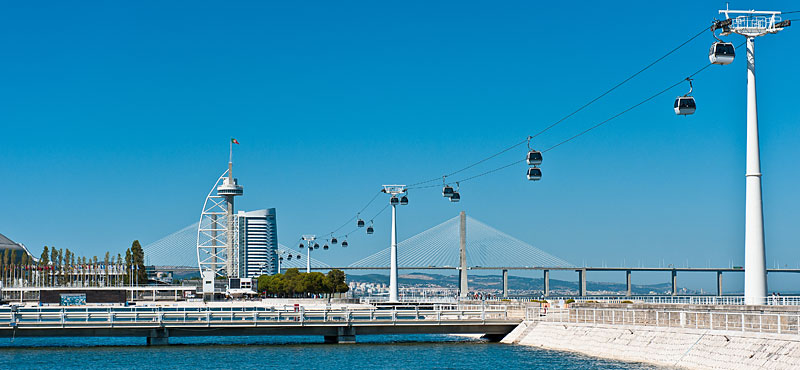
If Alfama is the historic and traditional district of Lisbon, the Park of Nations represents the futuristic side of Lisbon.
This huge area located along the east shore of the Tagus river is the result of one of the most successful urban redevelopment projects which managed to transform a former port area in the periphery of the city in a state of degradation and abandonment into one of the most modern and trendy areas of Lisbon.
The district was renovated for Expo 1998 World Exhibition, as Lisbon was chosen to host the last fair of the millennium that focused on the theme of “Oceans: an heritage for the future”. Abandoned storehouses and industrial complexes were replaced by futuristic palaces and pavilions capable of hosting thousand of visitors, offering a series of extremely efficient services.
Once Expo ended the pavilions were transformed into museums, auditoriums, and other attractions. One pavilion was transformed into the very popular Oceanarium. Today the Park of Nations is not only one of the most famous attractions of Lisbon, but it is also the most expensive residential area of the city, a financial center, the headquarter of the international fair and a shopping mall.
After visiting the charming old center of Lisbon, come and stroll around the modern side of Lisbon among skyscrapers, science museums, concert areas, water games, shopping malls, a futuristic station, the Europe’s longest bridge, and wide pedestrian spaces where to walk around. There is so much to do to keep you busy all the long.

Lisbon Oceanarium is one of the world’s biggest aquariums as well as one of Portugal’s most important attractions; it is visited every year by more than a million tourists and it is very popular among kids and adults.
Numbers are impressive; 15.000 animals and more than 400 species of marine plants divided into a main and other four smaller thanks that reproduce the natural habitat of the Pacific and Indian Oceans, as well as of the one of the Antarctic regions; 7 million liters of water are used to fill the tanks; a front yard decorated with more than 55.000 tiles.
Come and experience the unique emotion of seeing live (without getting wet), some extraordinary animals like sharks, rays, clownfishes, otters, penguins, sea dragons…
The Vasco da Gama Bridge was constructed to celebrate the famous Portuguese explorer and it represents one of the symbols of Lisbon. It connects the Park of Nations to Montigo.
The bridge was built during Expo 98 and it carries that same feeling of greatness and modernity that characterizes the other works that were built on that occasion. With a total length of 17km, it is Europe’s longest bridge and one of the longest bridges in the world.
Forget about walking on it; the bridge is designed for cars and it would be very risky for a pedestrian!
Orient station (Gara do oriente in Portuguese), is the main hub to the Park of Nations. All tourists going to the Oceanarium and other famous attractions around the area transit here. Most of the people cross the station without even paying attention to it.
Take some time to observe it, though, and to realize that the modern Oriente station is actually an interesting attraction to visit.
And it is not a coincidence if this jewel of contemporary art was designed by one of the most famous contemporary architects, that is to say the Spanish Santiago Calatrava, who is famous for its organic design characterised by the reproduction of natural shapes and structures.
Built for Expo and inaugurated in 1998, the station is built on three levels; one for the metro, one for trains (urban and long distance trains), and one for buses.
In order to see the most modern area of Lisbon from an original perspective, use the tourist cable car that rides through the Park of Nations. Admire the ambitious project of urban redevelopment and its success from a comfortable cable cabin.
The northern station of the cable car is located at Passeio das Tagides (next to the Vasco da Gama Tower), while the southern station is located at Passeio de Neptuno (near the oceanarium). The cable car ride lasts about 10 minutes.
The most visited pavilion during Expo 98 was the The Pavilion of Knowledge, where visitors has the unique opportunity to admire the central nave of a boat shipyards of San Jacinto.
Today the building is home to a kids interactive museum that aims at sharing scientific knowledge in a fun way; permanent and temporary exhibitions, games, activities, educational programs, and much more.
The MEO Arena is a futuristic entertainment temple characterised by the unique shape of a UFO. The arena is used to host concerts as well as cultural and sport events. It is one of the biggest arenas of Europe.
Lisbon Casino, which opened its doors in 2006, is the cherry on the cake of a new, expanding tourist area that already includes couple of hotels and clubs.
If you don’t like gambling, then just take a look at the facade of the casino, which is characterized by a unique structure of glass and steel.
In the following map you can see the location of the main places of interest mentioned in this article.
Although far from the centre, booking accommodation in the Park of Nations might be worth considering: it is a district full of modern palaces and buildings, trendy clubs and restaurants and numerous tourist attractions.
The Park of Nations can be easily reached from the old area of Lisbon and it is served by several public transports. The fastest way to get there is to take the metro and get off at Oriente station.
City Card allow you to save on public transport and / or on the entrances to the main tourist attractions.
